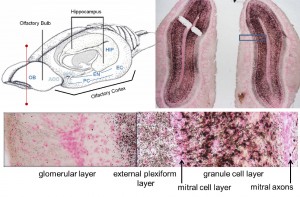Algal Toxin Causes Seizures by Damaging Olfactory Neurons

Neurons damaged by domoic acid appear black. A close up of the blue boxed area, below, shows blackened granule cells and their extended dendrites. Damage changes information processing and activates seizure-sensitive brain regions, which include the olfactory cortex and hippocampus.
NOAA researchers discovered how a harmful algal toxin called domoic acid targets the brain to induce seizures. Using a rat epilepsy model for the California sea lion, a species susceptible to poisoning by the toxin, they showed that it causes extensive damage to the olfactory bulb, a specialized brain region responsible for the perception of odors.
It alters the normal processing of odor, which can trigger a ‘domino effect’ of further damage along the neuronal pathways that leads to seizures in regions of the brain important for short-term memory. These seizures can eventually progress to a permanent disease state, similar to epilepsy in humans.
Microscopic analysis using special staining techniques revealed damage localized to olfactory granule cells found in the olfactory bulb. These cells send a ‘map’ of smell to the olfactory cortex of the brain. Together with the hippocampus that stores similar ‘maps’ of spatial information, these two regions provide the foundation for short-term memory.
The same researchers from NOAA’s National Centers for Coastal Ocean Science are now investigating how olfactory pathway damage may be sufficient to progress to a chronic state of epileptic disease observed long after domoic acid is eliminated from the body. It’s similar to symptoms of chronic neurological disease in some California sea lions. The paper is slated for physical release in the February 2013 issue of Toxicologic Pathology.
Read the article online: A Cupric Silver Histochemical Analysis of Domoic Acid Damage to Olfactory Pathways Following Status Epilepticus in a Rat Model for Chronic Recurrent Spontaneous Seizures and Aggressive Behavior
See also: Toxic Algal Blooms May Cause Seizures in California Sea Lions
Deep background: Sniff Sniff: Smelling Led to Smarter Mammals
Watch: Sea Lion Sickness, Usoceangov Ocean Today kiosk video
Fact sheet: Pseudo-nitzschia
Related NCCOS Center(s): CCEHBR
Related Region(s): California
Shorter web link for sharing: http://coastalscience.noaa.gov/news/?p=8468